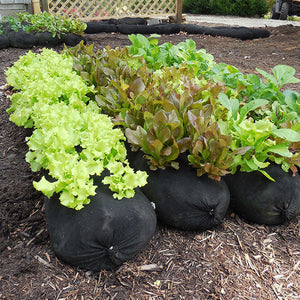When learning how to grow blackberries, know that even just one blackberry bush can provide an abundant harvest - perfect for on-the-spot snacking or collecting and preserving for jams and pies. Best of all, they are perennial and will return to provide you with more fruit year after year.
As with other berries, organic blackberries are known to be highly nutritious and are considered a superfood. High in vitamins, minerals, and dietary fiber, they are a great addition to your daily diet - providing a ton of antioxidants, helping to improve brain function, and boosting the immune system.

Growing blackberries in GardenSoxx® | Plant Family: Rosaceae
Different Varieties of Blackberries
While many different varieties of Blackberries exist, the following are some top choices for home gardens:
The Ouachita Blackberry variety is known for its sweet flavor and excellent yield. They hold up better than some other varieties, and the branches are thornless, making them a popular choice for market and home gardeners.
Triple Crown Blackberries boast an exceptionally sweet-flavored, large, and high-quality fruit. Also thornless, this variety is a bit softer than other popular varieties and should be eaten shortly after being harvested.
The Chester Blackberry is a variety that grows best when trellised and produces large, very sweet fruit - it is one of the most popular varieties due to the plant's hardiness and ability to withstand harsh winters.
Growers of Chickasaw Blackberries benefit from a long harvest season and very large, evenly formed fruit. This variety does have thorns, so caution is needed while harvesting.
Nutritional Information For Blackberries
Nutritional Facts - per 100/g
| Nutrient | Amount | % Daily Value |
|---|---|---|
| Calories | 43 | - |
| Total Fat | 0.5 g | - |
| Sodium | 1 mg | - |
| Potassium | 162 mg | - |
| Dietary Fiber | 5 g | - |
| Sugar | 4.9 g | - |
| Protein | 1.4 g | - |
| Vitamin C | - | 35% |
| Iron | - | 3% |
| Magnesium | - | 5% |
| Calcium | - | 2% |
How to Grow Blackberries in Your GardenSoxx®
Blackberries prefer slightly acidic soil that is rich in organic matter and well-draining. There are three types of blackberry bushes you can grow: Erect, Semi-Erect or Trailing - and while the erect bushes will not need any support, the other two will. Starting blackberries from seed can be a long process and you will likely not have a harvest for at least 2 years. We recommend purchasing a small bush from a nursery, and while you should get a harvest in the first summer they are planted, the harvest should increase significantly the following year. The bushes should be planted early in spring to give them a chance to root and grow.
Blackberries Seed to Harvest Time: Blackberries can take 2-3 years to produce a harvest when planted from seed.

How to Harvest Blackberries
Blackberries are best harvested by hand, and picked when they are perfectly ripe as they will not continue to ripen once removed from the plant. If the plant is wet from morning dew or rainfall, allow the berries to dry in the sun before picking them. Once they have been picked, consume them within 2-3 days for optimal freshness. Any longer than that, and they will be best suited for jam or a smoothie!























































